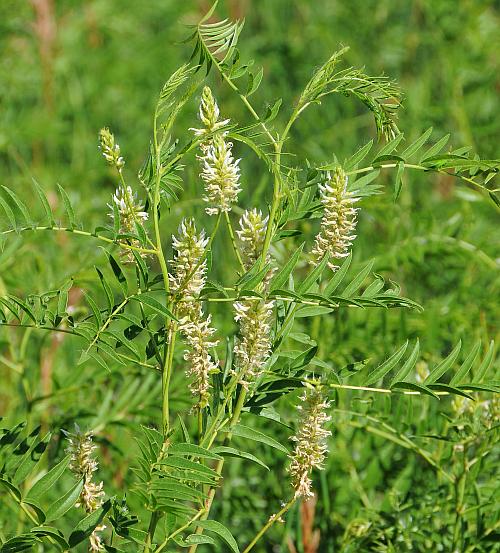Glycyrrhiza lepidota Pursh
Wild Licorice

Native
CC = 4
CW = 5
MOC = 9
SRank = S1
© DETenaglia
Glycyrrhiza lepidota PurshWild Licorice | |
 |
Native CC = 4 CW = 5 MOC = 9 SRank = S1 |
© DETenaglia |
|
Family - Fabaceae/Faboideae Habit - Perennial forb from deep, elongate, somewhat woody rhizomes, often colonial. Stem - Strongly ascending to erect, to 60 cm, often unbranched, unarmed, glabrous or sparsely to moderately pubescent with minute hairs, usually also gland-dotted, at least when young.
Leaves - Alternate, odd-pinnately compound with 11-19 leaflets, the petiole 0.5-3.0 cm long, the rachis 4-12 cm long. Stipules 3-7 mm long, linear to narrowly lanceolate, shed early. Leaflets 1-4 cm long, 0.4-1.0 cm wide, lanceolate to oblong-lanceolate or oblong, angled to somewhat rounded at the base, angled to a narrowly rounded to sharply pointed tip, the midvein usually extended into a short, sharp point at the very tip, the margins entire, the surfaces with sparse to moderate, minute scales when young, appearing gland-dotted after the scales are shed, sticky, the undersurface often also sparsely hairy, pinnately veined, but the secondary veins often relatively faint.
Inflorescences - Axillary, spikelike racemes of numerous flowers, strongly ascending, the stalk 2-7 cm long, the bracts 5-7 mm long, lanceolate, more or less persistent, each flower with an inconspicuous stalk 0.5-1.0 mm long; bractlets absent.
Flowers - Calyces densely pubescent with short, spreading hairs, most or all of these gland-tipped, the tube 2-3 mm long, narrowly bell-shaped, more or less 2-lipped, the lobes 2.5-4.5 mm long, the upper 2 lobes shorter and fused to above the midpoint, the lower 3 lobes longer, narrowly lanceolate-triangular, sharply pointed at their tips. Corollas papilionaceous, yellowish white to greenish white, the banner 9-12 mm long, 3-4 mm wide, the expanded portion somewhat ascending, ovate to elliptic-ovate, angled to a mostly sharply pointed tip, the wings 8-10 mm long, 1-2 mm wide, narrowly oblong, the keel 7-9 mm long, 1.5-2.0 mm wide, narrowly boat-shaped, fused below the midpoint, more or less straight below the sharply pointed tip. Stamens 10, unequal in length, 9 of the filaments fused and 1 free, the fused portion 3-4 mm long, the free portion 2-3 mm long, the anthers small, attached above the base, orange. Ovary 2-3 mm long, with raised glandular areas, becoming bristly, the style 1-3 mm long, somewhat curved toward the tip, glabrous, the stigma small and terminal. Fruits - Burlike legumes, the body 1.0-1.5 cm long, 4-6 mm wide, oblong-ellipsoid to narrowly ellipsoid, not beaked, somewhat flattened, straight, indehiscent, brown to dark brown, with dense, coarse, hooked prickles, mostly 2-4-seeded. Seeds 3-4 mm long, 2-3 mm wide, more or less kidney-shaped to somewhat trapezoid, the surface reddish brown to greenish brown, smooth, dull to slightly shiny.
Flowering - May - June. Habitat - Upland prairies, pond margins, pastures, railroads, open disturbed areas. Origin - Native to the U.S. Lookalikes - Astragalus canadensis. Other info. - This plant is rare in Missouri, found in only a few scattered counties, mainly in the northern half of the state. Only one collection has been made in the state within the last 60 years. It is, however, quite common across the western half of the continental U.S., with its main range beginning just to the west of Missouri. In general appearance the plant much resembles an Astragalus; however, it is easily differentiated by the unique fruits dense with hooked bristles. In addition, the upper stems and calyces are gland-dotted. Photographs taken near Hog Canyon, Uintah County, UT, 6-27-2018, and near the Bearmouth rest stop near Drummond, Granite County, MT, 8-15-2019 (SRTurner). |